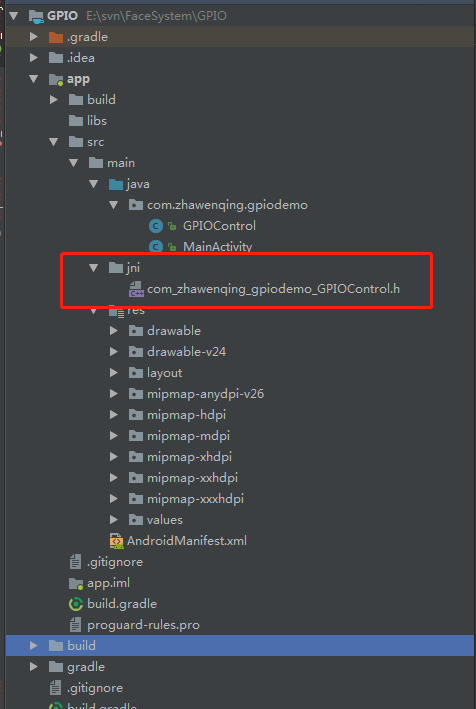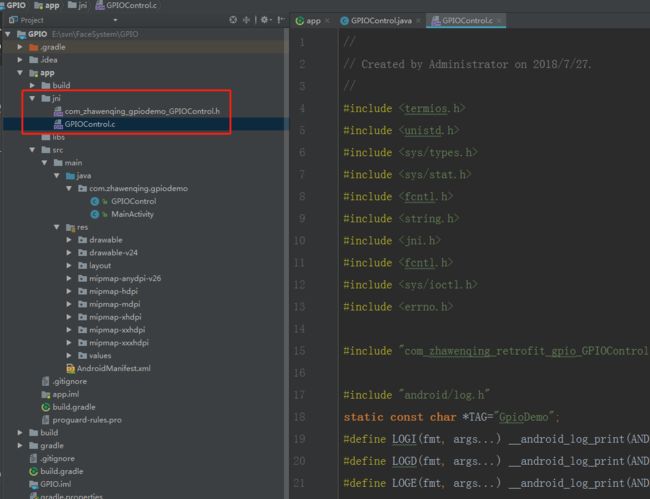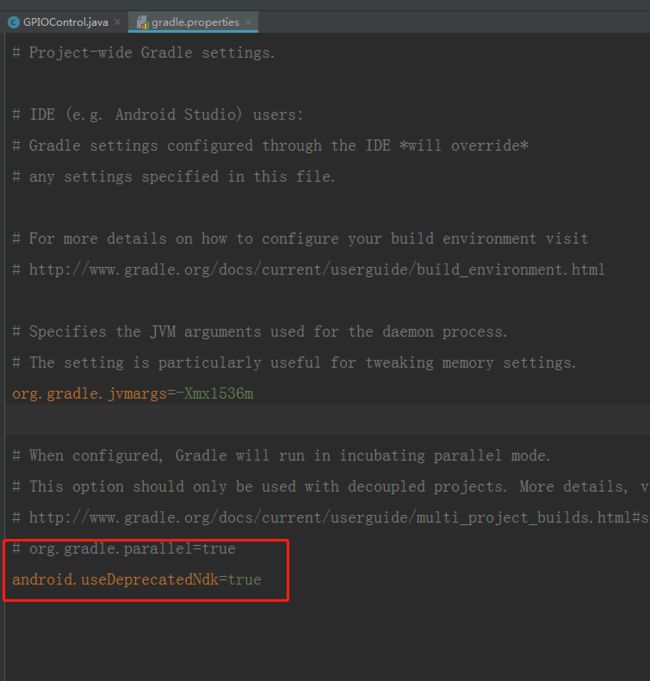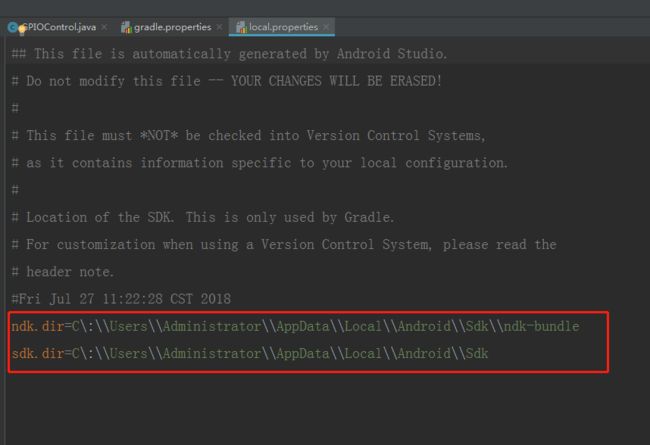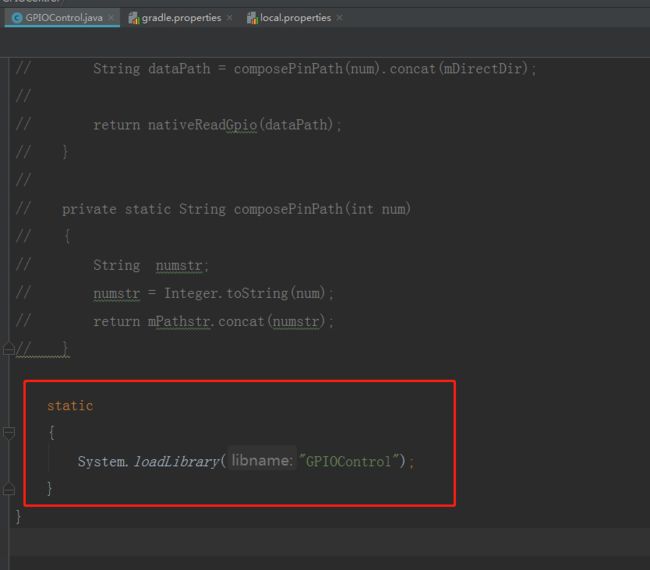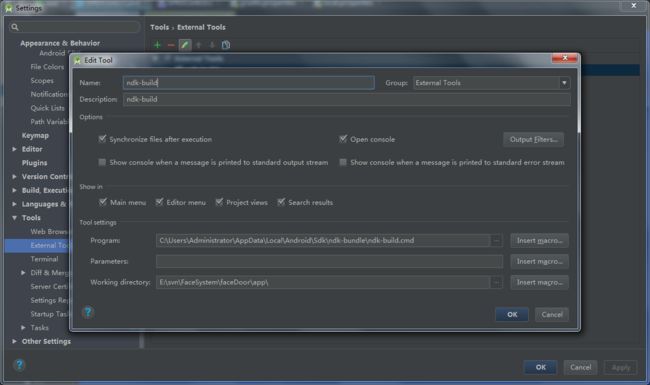一直以来做项目都是直接加载生成好的so文件,然后调用相关的封装方法来实现外接硬件的调用。平常我们使用android通过串口与单片机进行通讯,只需要对接RS232的串口通讯协议就可以了,因为我们不需要直接驱动底层的硬件。但是最近是需求通过Android 开发板上的I2C总线直接加装一块定制的开发板去驱动一些底层硬件,例如直接控制LED灯、驱动马达等动作。这时候就需要使用到GPIO。
1.首先我们创建一个项目,新建一个GPIOControl.java文件
2.写入自己需要的调用方法
public class GPIOControl {
static
{
System.loadLibrary("GPIOControl");
}
// JNI
public static native int nativeReadGpio(String path);
public static native int nativeWriteGpio(String path, String value);
}
3.点击build重构下项目
4.使用Terminal命令窗口创建.h头文件
cd app/build/intermediates/classes/debug //跳到指定的文件夹下
javah -jni com.zhawenqing.gpiodemo.GPIOControl //编译c的头文件,jni后面是文件路径
5.在app/build/intermediates/classes/debug目录下找到生成的.h文件复制,右键app新建一个jni文件夹放置.h文件。并且需要把jni文件夹移动到app目录下否则会报错,具体报错请往下看
6.在jni文件夹新建GPIOControl.c文件并实现.h文件里面的方法
具体实现方法的相关代码,注意里面方法的方法名要与生成的.h里面的方法名必须保持一致
Java_com_zhawenqing_retrofit_gpio_GPIOControl_nativeReadGpio。需要将GPIOControl中封装方法添加完整。
下面是GPIOControl.java文件
package com.zhawenqing.gpiodemo;
/**
* Created by Administrator on 2018/7/27.
*/
public class GPIOControl {
// JNI
public static native int nativeReadGpio(String path);
public static native int nativeWriteGpio(String path, String value);
private static final String mPathstr = "/sys/class/gpio/gpio";
private static final String mDirectDir = "/direction";
private static final String mValueDir = "/value";
public static int writeGpioValue(int num, int value) //设置gpio输出电平,value=0为低电平,value=1为高电平,num为gpio口序列号
{
String dataPath = composePinPath(num).concat(mValueDir);
return nativeWriteGpio(dataPath, Integer.toString(value));
}
public static int readGpioValue(int num)
{
String dataPath = composePinPath(num).concat(mValueDir);
return nativeReadGpio(dataPath);
}
public static int writeGpioDirection(int num, int value) //设置gpio口输入输出状态,value=0为输入,value=1为输出,num为gpio口序列号
{
String dataPath = composePinPath(num).concat(mDirectDir);
String direct;
if(value == 0)
{
direct = "in";
}
else if(value == 1)
{
direct = "out";
}
else
{
return -1;
}
return nativeWriteGpio(dataPath, direct);
}
public static int readGpioDirection(int num)
{
String dataPath = composePinPath(num).concat(mDirectDir);
return nativeReadGpio(dataPath);
}
private static String composePinPath(int num)
{
String numstr;
numstr = Integer.toString(num);
return mPathstr.concat(numstr);
}
static
{
System.loadLibrary("GPIOControl");
}
}
下面是GPIOControl.c文件
//
// Created by Administrator on 2018/7/27.
//
#include
#include
#include
#include
#include
#include
#include
#include
#include
#include
#include "com_zhawenqing_retrofit_gpio_GPIOControl.h"
#include "android/log.h"
static const char *TAG="GpioDemo";
#define LOGI(fmt, args...) __android_log_print(ANDROID_LOG_INFO, TAG, fmt, ##args)
#define LOGD(fmt, args...) __android_log_print(ANDROID_LOG_DEBUG, TAG, fmt, ##args)
#define LOGE(fmt, args...) __android_log_print(ANDROID_LOG_ERROR, TAG, fmt, ##args)
JNIEXPORT jint JNICALL Java_com_zhawenqing_retrofit_gpio_GPIOControl_nativeReadGpio(JNIEnv *env, jclass thiz, jstring path)
{
if(path == NULL)
{
return -1;
}
const char *chars = (*env)->GetStringUTFChars(env, path, NULL);
int ret = readData(chars);
(*env)->ReleaseStringUTFChars(env, path, chars);
return ret;
}
JNIEXPORT jint JNICALL Java_com_zhawenqing_retrofit_gpio_GPIOControl_nativeWriteGpio(JNIEnv *env, jclass thiz, jstring path, jstring value)
{
if(path == NULL)
{
return -1;
}
const char *chars = (*env)->GetStringUTFChars(env, path, NULL);
const char *valueStr = (*env)->GetStringUTFChars(env, value, NULL);
int ret = writeData(valueStr, strlen(valueStr), chars);
(*env)->ReleaseStringUTFChars(env, path, chars);
(*env)->ReleaseStringUTFChars(env, value, valueStr);
return ret;
}
int readData(const char * filePath)
{
int fd;
int value;
fd = open(filePath, O_RDWR);
if(fd < 0){
return -1;
}
char valueStr[32];
memset(valueStr, 0, sizeof(valueStr));
read(fd, (void *)valueStr, sizeof(valueStr) - 1);
char *end;
if(strncmp(valueStr,"in",2) == 0)
{
value = 0;
}
else if(strncmp(valueStr,"out",3) == 0)
{
value = 1;
}
else
{
value = strtol(valueStr, &end, 0);
if(end == valueStr){
close(fd);
return -1;
}
}
close(fd);
return value;
}
int writeData(const char * data,int count,const char * filePath)
{
int fd;
fd = open(filePath, O_RDWR);
if(fd < 0)
{
return -1;
}
int ret = write(fd, data, count);
close(fd);
return 0;
}
7.配置并打开ndk,在项目的gradle.properties文件中添加android.useDeprecatedNdk=true
8.打开项目中local.properties文件,确认是否配置ndk
9.在app的build.gradle文件中添加ndk配置,这个需要具体根据开发用的Android板CPU框架,moudleName这个自定义的,保持和新建的方法封装库名称一致
ndk {
moduleName "GPIOControl"
//选择要添加的对应cpu类型的.so库。
abiFilters 'armeabi'
}
10.配置ndk-build
点击file->setting->tools->external tools 点击+新建一个tool
具体配置如下:
Program:C:\Users\Administrator\AppData\Local\Android\Sdk\ndk-bundle\ndk-build.cmd
Working directory: E:\svn\FaceSystem\faceDoor\app\
点击OK,完成ndk-build配置
11.在jni文件夹创建.mk文件,让ndk-build动态生成so库
12..mk文件语法
1> LOCAL_PATH := $(call my-dir)
每个Android.mk文件必须以定义LOCAL_PATH为开始,它用于在开发tree中查找源文件,宏my-dir 则由Build System提供,返回包含Android.mk的目录路径。
2> include $(CLEAR_VARS)
CLEAR_VARS 变量由Build System提供。并指向一个指定的GNU Makefile,由它负责清理很多LOCAL_xxx.
3> LOCAL_MODULE模块必须定义,以表示Android.mk中的每一个模块。名字必须唯一且不包含空格
4> LOCAL_SRC_FILES变量必须包含将要打包如模块的C/C++ 源码,不必列出头文件,build System 会自动帮我们找出依赖文件。
application.mk文件代码:
APP_ABI := armeabi armeabi-v7a x86
Android.mk文件代码:
LOCAL_PATH := $(call my-dir)
include $(CLEAR_VARS)
TARGET_PLATFORM := android-23
LOCAL_MODULE := GPIOControl
LOCAL_SRC_FILES := GPIOControl.c
LOCAL_LDLIBS := -llog
include $(BUILD_SHARED_LIBRARY)
13.mk文件创建好后,我们重新ndk-build一下,我们将会成功编译好so库,将会自动生成一个obj文件夹
14.还需要手动创建一个jniLibs文件夹,将我们手动编译完成的so库复制,如果读取不到jniLibs文件夹里面的资源,需要
sourceSets {
main {
jniLibs.srcDirs = ['libs']
}
}
对于以上的问题,如果出现以下错误
Error: Flag android.useDeprecatedNdk is no longer supported and will be removed in the next version of Android Studio. Please switch to a supported build system.
Consider using CMake or ndk-build integration. For more information, go to:
https://d.android.com/r/studio-ui/add-native-code.html#ndkCompile
To get started, you can use the sample ndk-build script the Android
plugin generated for you at:
E:\SwimmingSpace\ndktest\build\intermediates\ndk\debug\Android.mk
Alternatively, you can use the experimental plugin:
https://developer.android.com/r/tools/experimental-plugin.html
To continue using the deprecated NDK compile for another 60 days, set
android.deprecatedNdkCompileLease=1515138691572 in gradle.properties
这种错误是由于启动ndk时出错,在gradle.properties文件里把android.useDeprecatedNdk去掉换成android.deprecatedNdkCompileLease=1515138691572就行了。具体后面的值需要根据错误提示中的提示值填入就可以了。
调用GPIO
GpioControl.writeGpioDirection(192, 1); //设置PG0为输出
int nDirect = GpioControl.readGpioDirection(192); //读取PG0的输入输出状态
GpioControl.writeGpioValue(192, 1); //PG0为输出时,设置为高电平
int nValue = GpioControl.readGpioValue(192); //读取PG0的输出电平
具体PG口对应的序列号需要参考厂家的规格书上的定义。我这边是PG0对应192,以此类推。
最后如果出现奇特的编译器错误,那么就尝试从头开始,每完成一个步骤都尽量rebuild一下项目。NDK开发中jni的配置是一门玄学,需要静下心来慢慢探索属于自己的方法。我也是折腾了一天才能总结出以上步骤。





